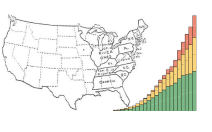As described in the Introduction, there were several major changes in the decennial census from 1790 to 2000. None of these changes affected one of the basic characteristics of a decennial census: the collection of data at 10-year intervals to provide information about the population.
This situation changed between 2000 and 2010 with what is arguably the biggest change in U.S. decennial census history. From 1960 through 2000, basic population and housing information was collected with a few questions on the “short form” that covered the entire population, and most information, including information on wide range of social, economic, and housing characteristics, was collected on a sample basis with a larger number of questions on the “long form.”
In order to simplify operational aspects of the decennial census (the primary purpose of which is to fill the constitutional requirement for a count of population for apportionment purposes) and to provide more frequent data on population and housing characteristics for small areas (for which existing national surveys like the Current Population Survey do not provide data), the 2010 decennial census was restricted to the short form, and the long form was removed from the decennial census and replaced by the American Community Survey (ACS).
The ACS is an ongoing survey that collects information monthly throughout the United States. These monthly data can be aggregated to produce annual estimates (12-month average data). ACS data collected from 2000 through 2004 were published annually (in the year following data collection) for geographic areas of 250,000+ population. Starting with data collected in 2005, annual estimates were published for geographic areas with 65,000+ population.
Annual average data can be aggregated to produce multiyear estimates. The original sample design for the fully-implemented ACS called for a 3-percent sample of the population each year so that 5-year average estimates would be based on a 15-percent sample of the population, thereby approximating the sampling rate for the long form in the 2000 census. Based on this design, the Census Bureau determined population thresholds for producing estimates from the ACS: annual estimates for geographic areas of 65,000+ population, 3-year annual average estimates for geographic areas of 20,000+ population, and 5-year annual average estimates for all geographic areas (including statistical areas like census tracts).
Unfortunately, due primarily to budget cuts, the actual sample size for the ACS is only about one-half as large as originally planned. As a result, sampling errors for ACS estimates are larger than would be the case if the original sample design could have been implemented each year.
Fortunately, the relatively small sample in the ACS does not pose a major problem for the analysis of historical trends and differentials, as shown in the Chartbook, for two reasons. First, the geographic areas for which data for 2010 are shown in the Chartbook all have a population of at least 500,000 (and much larger in most cases) so that sampling errors for estimates for 2010 are still relatively small. Second, since the comparisons are decade to decade rather than year to year, apparent changes are more likely to be large enough to be statistically significant.
One drawback of the ACS for historical comparisons is that the Census Bureau has focused on producing the huge quantity of tabulations now available (three sets of estimates each year in place of decennial census data once every 10 years). As a result, more detailed tabulations that have historically been published for higher-level geography (such as the United States, regions, and states) have not been produced, at least so far. For example, a table showing state-to-state lifetime (state of birth by state of residence), which was published in each census from 1850 through 2000, has not been produced using 2010 ACS data. This tabulation underlies the data shown in Figure 11-5. Such tabulations can be developed using sample data on the PUMS file for the 2010 ACS, although the results will differ slightly from the results that would have been produced by using the full 2010 ACS sample data and thus will be slightly inconsistent with data from the 2010 ACS as published by the Census Bureau.
While, as noted earlier, the relatively small sample size in the ACS does not pose a major problem for the analysis of trends and differentials as shown in the Chartbook, it should be noted that in general, the analysis of trends and differentials is much more complicated using ACS data than traditional decennial census data, especially for geographic areas with relatively small populations. This is due to three interrelated factors: (1) the smaller sample size in the ACS, (2) the need to choose between 1-year, 3-year, and 5-year data where available (which involves a tradeoff between reliability, as measured by sampling error, and currency), and (3) the fact that in general, statistically significant change is more likely to occur and to be detectable for a 10-year period than for a much shorter period, especially one year.
For 2010, data on topics shown in figures in chapters 1 through 6 and in Figure 8-3 in the Chartbook are from the decennial census. Data for 2010 on other topics shown in figures in the Chartbook are from the ACS.
The Census Bureau has issued (in PDF) several reports under the general title of A Compass for Understanding and Using American Community Survey Data. The full series is available at www.census.gov/acs/www/guidance_for_data_users/handbooks/. In particular, it is strongly suggested that at a minimum, the user of ACS data read the first report in the series: What General Data Users Need to Know (by Linda A. Jacobsen and Mark Mather; issued October, 2008).
